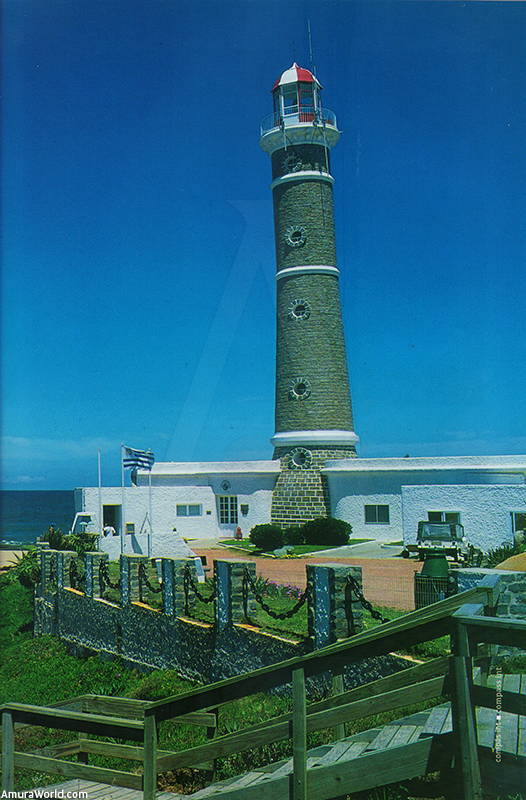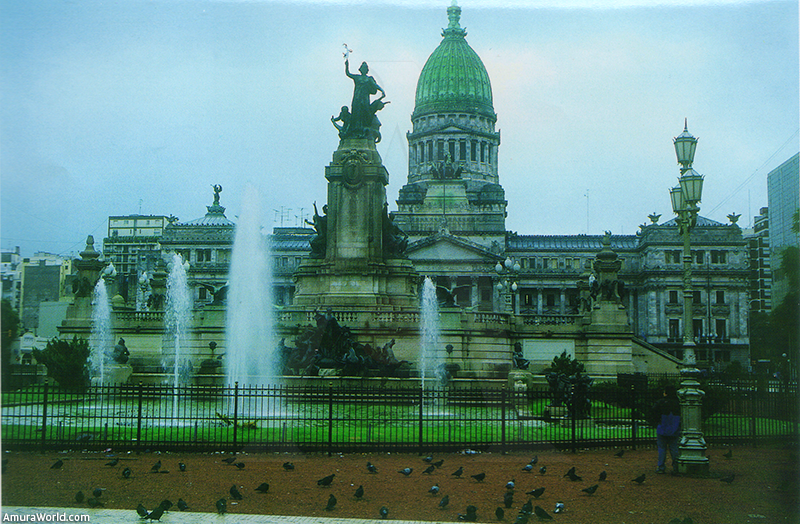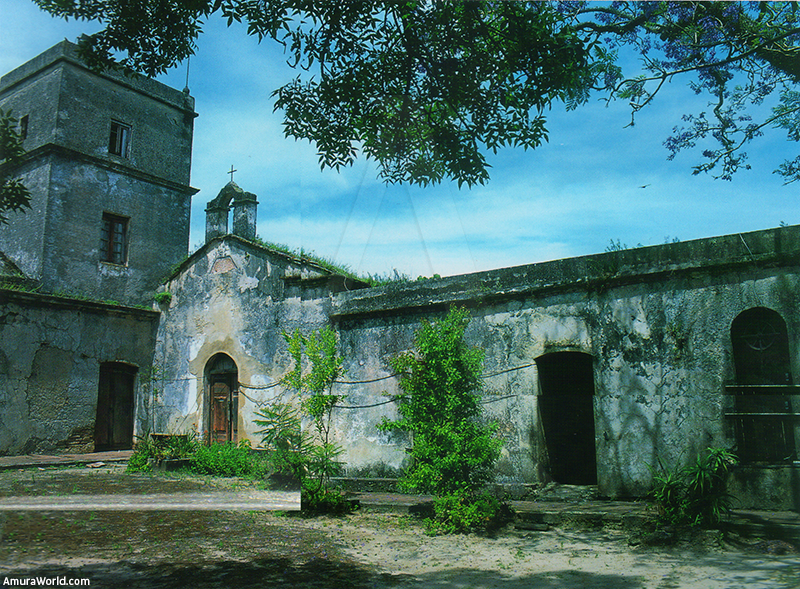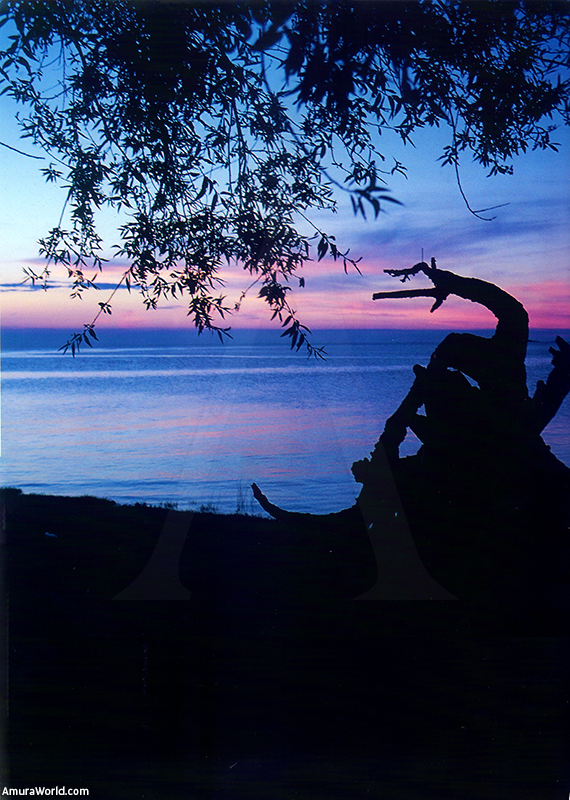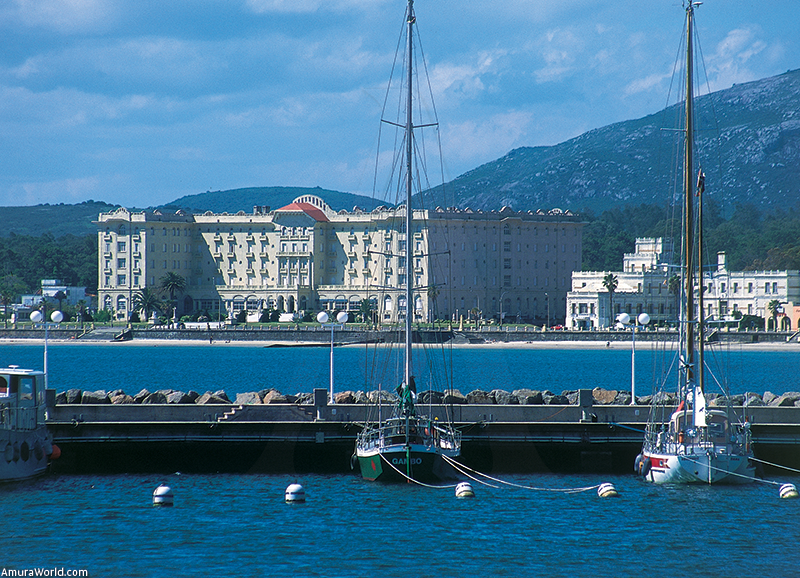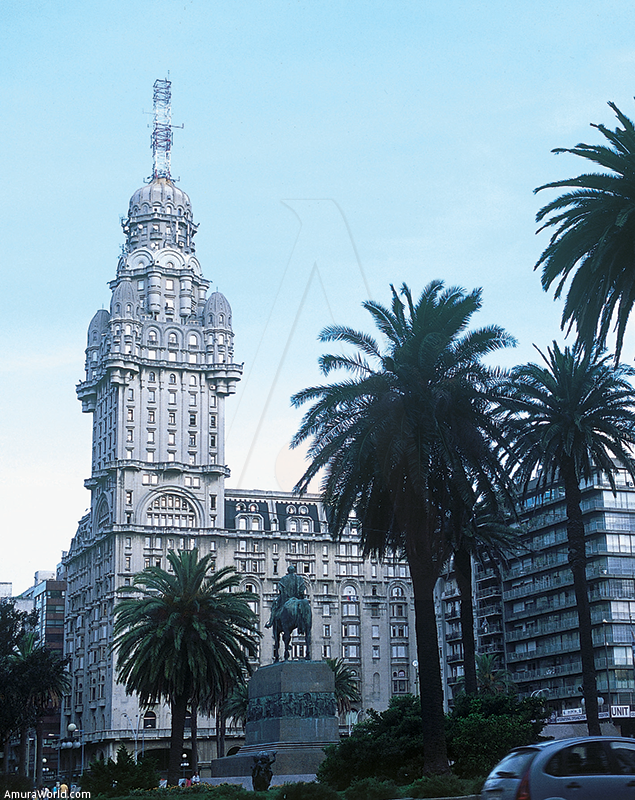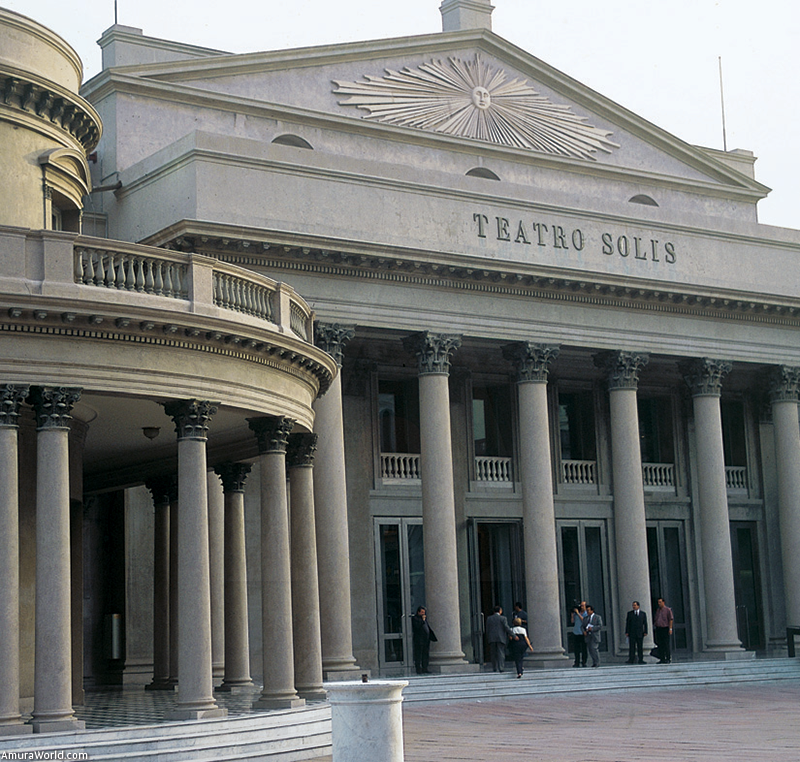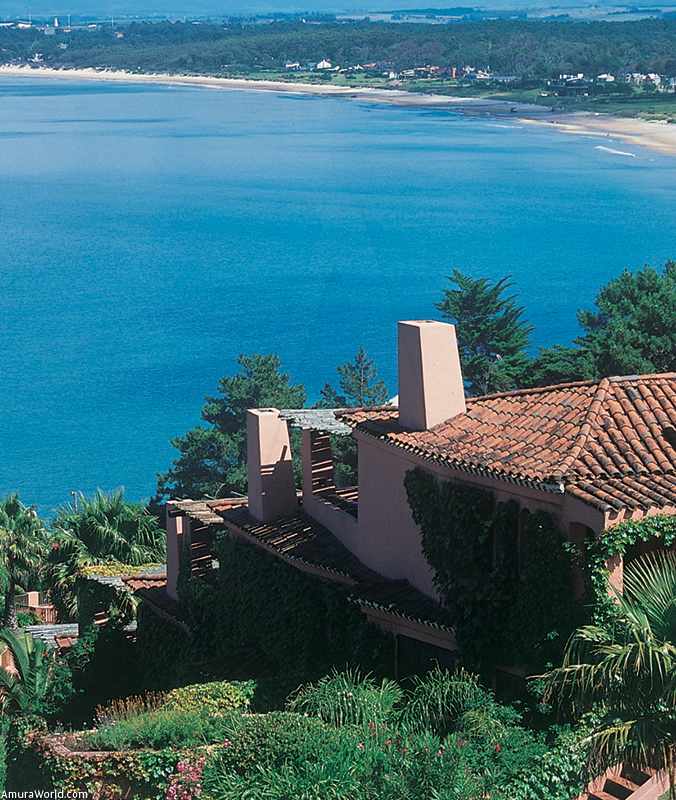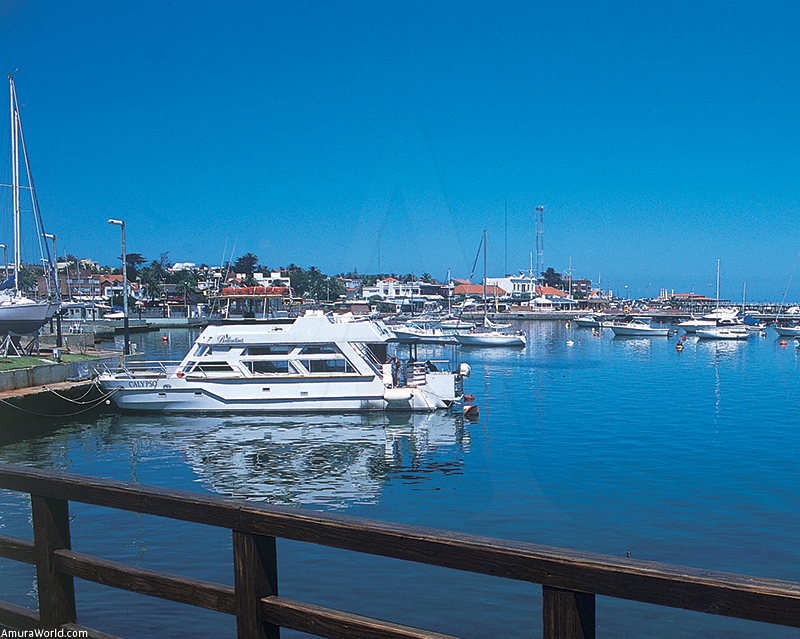Buenos Aires shines with a thousand lights and its reflection dances, to the rhythm of the tango, on the Rio de la Plata. The theaters are full, the restaurants are open till dawn and. from the discos, you can hear the sounds of rock or the sighs of Gardel. The Southern Cone's most European city is a star with a melancholy undercurrent, where Puerto Madero sheltered our boat before we set out to explore the immense Rio de la Plata. It flows into the Atlantic, where it is crowned by Punta del Este. the elegant summer capital of the Republic of Uruguay and one of the most popular beaches in the world.
Founded in 1536, Buenos Aires really started to grow in 1840, with the arrival of European immigrants, mostly Italian. It is now an exciting capital with many lively neighborhoods.
La Recoleta is the heart of the most elegant part of town. It has designer shops next to museums, luxury hotels, terraces crowded with people sunbathing while seeing and being seen, beautiful women and art galleries. On weekends the parks are filled with artisans and people who come to look around, some also sunbathing on the grass, and there is always something to see after visiting the cemetery and the tombs of famous personalities like Evita Per6n. The center is the hustle and bustle of Florida Street, the elegance of 9 de Julio Avenue with the Colon Theater, the turbulent history that is guarded by the Plaza de Mayo (May Plaza), dominated by the Casa Rosada, the Cathedral and Town Hall. Tree-shaded Avenida de Mayo, with its stylish buildings and legendary Cafe Tortoni, opens onto the plaza.
San Telmo is a bohemian neighborhood. It has cobblestone streets, antique shops and the Plaza Dorrego where, on Sundays, there is a flea market and where you can watch the timeless tango performed by street dancers. La Boca is another neighborhood where they dance the tango: it has houses painted in bright colors and the renowned Caminito street, made famous by Gardel. It is populated by artists, restaurants and tourists.
Sailing from Buenos Aires
Buenos Aires is a city with several hearts. Each one beats to a different rhythm and has a unique flavor: the tango of La Recoleta is different from that of La Boca but. in the heart of its citizens, this dance is anchored here forever.
Puerto Madero, the old warehouse district, has become a trendy place to dine and its marina is welcoming. In the morning, when the music of the suburbs takes a rest, we discreetly left Puerto Madero. passed Dársena Norte, where boats heading to Uruguay are docked, and sailed west, in flat, silverhued water and no wind.
We sailed by engine and quickly reached the delta formed by the Lujcin, Tigre and Parana rivers, where there are more that 2.000 kilometers (1,243 miles) of channels, some with beautiful weekend homes. This is Argentina’s Venice, hidden among the foliage and the beautiful gardens. There is good fishing in its rivers, as the herons know, and in the Tigre market you will find abundant fruit, handicrafts and the best parrilladas (grilled meat). The Parana River is where rowing competitions are held.
Exploring these charming channels, crossing the Parana Mini, the Parana Principal and the Parana Guazu, led us to the mouth of the Uruguay River, which flows into Rio de la Plata long after passing the marvelous Iguazu waterfalls. The brown sand beaches. the Mediterranean vegetation and the light breeze create a special ambiance in this place where the shallow waters force you to sail carefully before entering the Arroyo de las Vacas and its marina.
In Uruguay
Carmelo is a peaceful town nestled in a beautiful setting. We discovered charming Granja Narbona and its vineyard, a rustic inn where you can enjoy the region's excellent cheese accompanied by delicious wines that taste of sun and sandy earth.
Four Seasons Carmelo is another surprise. It has an 18-hole golf course, a relaxing Spa, tennis courts, a beach and a swimming pool. Once a hacienda, the 18th century Estancia de Narbona and its chapel stand in ruin, evidence of the greatness of its past.
The Uruguayan countryside is an invitation to breathe pure air in a simple, natural setting, enjoying good conversation with charming people and a delicious parrillada, watching a game of polo or admiring the skill of the gauchos as they round up cattle or sheer sheep.
Sun and fresh air. a light breeze towards the east., these are the conditions for a new day of sailing, following a wavy coast of green hills, to reach Colonia del Sacramento, located opposite Buenos Aires, an hour away in buquebus (a ferry), with a very inviting marina.
Founded by the Portuguese Manoel Lobo. in 1680, it became important because of the contraband that circulated here in response to the monopoly that the Spanish imposed on trade in the region. English products found their way to the Spanish colony of Argentina through suspicious exchanges with the Portuguese. The merchants of Colonia became rich and built beautiful homes from which they traded in gold, silver, precious stones, English and German merchandise and Black slaves, without any benefit for the Spanish.
It was finally conquered in 1762 and commerce declined after 1777 because it was carried out directly in Buenos Aires. Now, it is a tranquil town where the sun paints the cobblestone streets silver and the high roofed houses open their long windows, protected by grill work, to the breeze that wafts in from the river. Its wall preserves the charm of a mysterious past, a time when pirates came though its door.
The Calle de los Suspiros (Street of Sighs), in the shadow of the lighthouse, guarded the romantic liaisons of the merchants’ daughters, and the patios of the houses, with their Mediterranean foliage and fountains, lie hidden behind the colonial facades. On the banks of the river fishermen catch fish at sunset, people stroll, chatting about soccer, polo, a good parrillada and about the ancient cars, still in excellent shape, which are found all over the country and are a real Uruguayan passion.
The cathedral, proudly dominating the Plaza de Armas, was built in 1680 and was modified several times until if was finally rebuilt in 1842. Colonia is a charming place that takes us back in time.
The sun came out accompanied by some clouds, a good wind blew from the east and this helped us sail towards Montevideo. We followed the green coast and reached it quickly without having to do much maneuvering.
By the time we arrived, the sun was shining and there was a slight counter-breeze from the Atlantic. The air smelled different, with a tang of iodine, and the water had a coffee-silver tone… but not that of a river. We went around the active port, the old city that rises in front of modern buildings and Punta Brava, with its lighthouse, to reach the east coast and the fabulous Puerto de Buceo marina.
On Pocitos Beach, people enjoyed the onset of the heat, lying in the sun, strolling, conversing, sipping mate or playing soccer. Montevideo is a charming city, a great metropolis with a taste of the country, a river port with the aroma of the sea, a modern world sprinkled with traditions of the past.
The Plaza de la Independencia (Independence Plaza), framed by tall buildings, is the ideal place from which to discover the Teatro Solís (Solís Theater), the old door of the citadel that opens onto Sarnadí Street, a shopping street closed to traffic, which leads to the Plaza de la Constitución (Constitution Plaza), dominated by the Matriz church and Town Hall.
Montevideo, the beautiful
Here you will find a series of narrow streets with beautiful buildings, palaces and museums. This is the Montevideo of long ago, which lives to the rhythm of its Mercado del Puerto (Port Market), where you can sample the best seafood and parrilladas. The ambiance of this typical market is that of a permanent fiesta, people talk and hug, laugh often and you can fill your senses with the aroma of the Serrano hams, cheeses, chorizos and paellas…
Contrasting with this popular spot is the Carrasco neighborhood, its shaded avenues framed by elegant mansions. The restaurants here vie in elegance and bars, and welcome young people driving the latest cars. The beaches on the east, that flank Punta Gorda, are an introduction to the sea and are very popular with residents, who appreciate their beauty. There was not a cloud in the blue sky on the pleasant day that we sailed to Punta del Este.
There was a slight wind against us, which forced us to change direction. The coast flaunted its golden sand beaches, adorned by a green ribbon of vegetation and several towns and summer homes. The river tasted, more and more, like the sea.
Piriápolis is an exquisite port lying at the foot of the San Antonio mountains. Forgotten during the winter, it comes alive with the arrival of summer, when people flock to the beaches. It is dominated by the beautiful, rococo Hotel Argentino, a witness to its past.
Piriápolis is an excellent place to stop and enjoy one of its famous seafood parrilladas in the La Langosta (The Lobster) restaurant.
Punta del Este
In the afternoon we sailed with the same breeze on the beautiful bay between Punta Negra and Punta Ballena. It displays its stunning residences and the extravagant home-town of Carlos Pérez Vilaró. Finally, raising its towers on the horizon, appeared Punta del Este, at the end of a long beach framed by dunes and pine trees.
Passing Gorriti Island with its outstanding beaches, transparent waters and the ruins of the Santa Ana fortress (18th century), we entered the port’s marina, which is protected from the Atlantic by a point on which a blue lighthouse stands. Punta del Este is alive in the warm summer, its restaurants are places where visitors come to dine, to see and be seen. Restaurants and fashion change style, parties are held in the mansions hidden in the pine forests and the beaches are packed: some prefer the peaceful ones on the west side while others like the ones on the east side, where the Atlantic waves lash the coast and seals fish. Elegant boutiques adorn the avenues, Gorlero Avenue glows in the different colors of the ads, the casinos imitate Las Vegas and restaurants, serving the best seafood, fish parrilladas, sausages and succulent meat, ring with voices and the clatter of the silverware.
The beaches come to life in the afternoons because the nights are long and watching the sunrise every day at Brava beach is a delightful experience. To the north, the Atlantic beaches with their golden sand dunes stretch out, waves challenge the boats and we reach charming José Ignacio, a fishing village guarded over by its lighthouse, passing La Barra, a small town of beautiful houses where the Maldonado stream flows. It is a favorite of surfers.
Isla de Lobos, six miles from the coast, is a shelter for 300,000 southern seals and was declared a natural reserve. The coastal lagoons are home to a great variety of birds like pelicans, ducks and herons, which find their favorite foods in these places.
Taking advantage of the two days in Punta el Este, we were sure to keep an afternoon appointment to have tea and the delicious cakes served in the renowned Hotel Art Las Cumbres. Set on Colina de la Ballena (Whale Hill), it overlooks the spectacular scenery of Punta del Este bay, where the Río de la Plata ends and the ocean begins. This is the ideal spot for running into celebrities, those who fill the pages dedicated to the beautiful people, in the most famous resort in the Southern Cone.
Lying in the shadow of its lighthouse is a neighborhood of elegant homes, which are witnesses to the founding of this exclusive beach resort. However, the most impressive ones are hidden in the pine forest on the edge of this city of buildings. Punta del Este has known how to preserve its fascinating ecosystem that is located near a city which vibrates in the summer heat and hibernates in the winter cold, when the southern winds blow in polar air. Under a pale blue sky and a prevailing southwestern wind, a sign of approaching bad weather, early the next day we sailed on the last part of our journey to Buenos Aires. The wind pushed us almost in a straight line and, little by little, the blue sea turned into a brown river. On the horizon, the coasts of Uruguay disappeared and, to the south, rose those of Argentina. Montevideo’s silhouette faded a long time before Buenos Aires’ came into sight.
Thanks to a good wind, we reached Puerto Madero when the lights of the tango capital were reflected in the river, dyeing the silver waters with gold and painting the clouds appearing to the east in pink. Enveloped in the hustle and bustle of the great city, we forgot that we were tired and got swept up in the whirlwind of the nightlife, which took us to the Café Tortoni to see the best tango dancers. Río de la Plata is like a wide, open smile lying on the Atlantic coast of South America. Fed by the Uruguay and Paraná rivers, it shelters heavenly destinations which make the dreams of many sailors a reality.
Text: Patrick Monney ± Photo: Patrick Monney.

